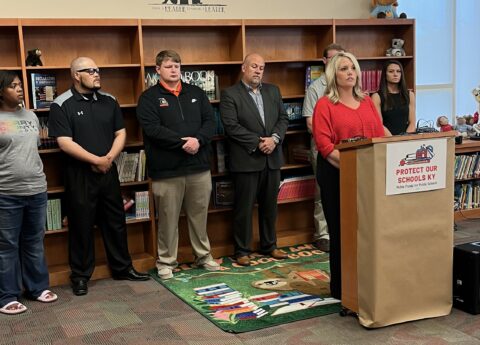Kentucky continues to undermine state funding for K-12 education, once again landing in the bottom 3 states for cuts to core school funding since the Great Recession, according to a new report by the nonpartisan Center on Budget and Policy Priorities (CBPP).
CBPP’s report shows that when it comes to cuts in core formula funding for elementary and secondary schools since 2008, Kentucky has cut funding per student by 15.8 percent, once adjusted for inflation. Only Oklahoma and Texas rank worse. The commonwealth is one of seven states that cut core funding as recently as this past fiscal year. Only Mississippi and West Virginia cut more in the latest fiscal year.
“States must invest in their schools, so that children can receive the education they need to succeed in life,” said Kenny Colston, communications director for the Kentucky Center for Economic Policy. “With looming pension obligations, this report is once again evidence of the need to clean up the tax code of special interest loopholes to help Kentucky reinvest in our state’s schools, among other needs.”
This erosion in support for K-12 education has damaging economic consequences for the state — both now and in the future. School cuts can undermine proven education reforms such as reducing class sizes, improving teacher quality, increasing learning time and expanding early childhood education.
The state cuts have meant more pressure on Kentucky’s local school districts. Poorer districts, especially those in the struggling coal fields, simply cannot compensate for the lost revenue. Many districts are having to make difficult budget decisions about reducing or eliminating staff, student supports, courses, and art and music programs. In addition, many are unable to give staff raises or meet facility needs.
According to Michael Taylor, superintendent of Fairview Independent Schools in Ashland, Ky., the cuts have already had devastating effects.
“The district has had to reduce classified and certified staff to the bare minimum. We cannot cut personnel any further and still operate as a school district,” Taylor said. “We have been unable to purchase new buses to replace old ones that require constant maintenance to keep operating.”
Another superintendent, Debbie Stephens of Elliott County Schools, said the cuts have already affected student/teacher ratios.
“We have been unable to maintain the number of staff that enables us to keep our student/teacher ratio numbers as low as we would like,” Stephens said. “We are also unable to provide up-to-date instructional resources (especially textbooks) for many of our classrooms. Finally, we often must postpone and prioritize facilities needs and are unable to make needed repairs in a timely manner.”
Cuts in funding for schools weakens the economy in the long term. Quality elementary, middle and high school education provides a crucial foundation that helps children to succeed in college and in the workplace. Much of the money they earn as adults is returned to the state economy through taxes and spending at local businesses. In addition, school budgets that force school layoffs or cut pay for teachers and other staff can reduce purchasing power and slow the pace of the economic recovery.


